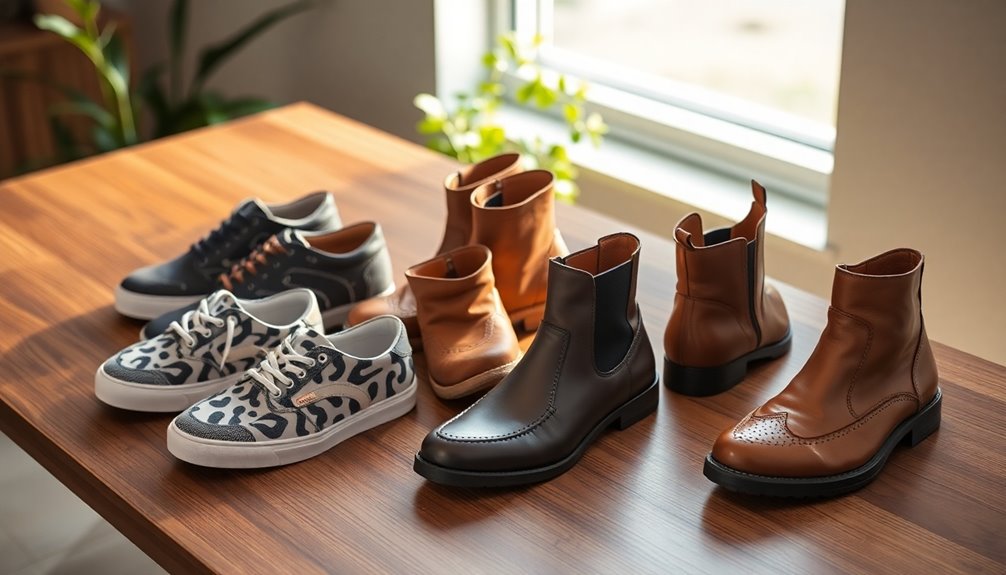The little black dress, pioneered by Coco Chanel in the 1920s, changed fashion by moving away from ornate styles to simple, elegant designs. It became a symbol of independence, confidence, and versatility, suitable for day or night wear. Throughout history, it reflected societal shifts, wartime resilience, and modern femininity. Its timeless appeal continues to inspire new styles and societal change. Explore further to discover how this iconic garment still shapes fashion today.
Key Takeaways
- Coco Chanel revolutionized fashion by introducing the sleek, minimalist black dress, shifting focus from ornate to simple elegance.
- The Little Black Dress became a versatile wardrobe staple, suitable for both day and night wear, symbolizing modern femininity.
- It reflected societal changes, empowering women with confidence, independence, and self-expression through accessorizing.
- During wartime and periods of austerity, it symbolized resilience, hope, and solidarity, maintaining its status as an icon of effortless chic.
- The LBD continues to evolve with fashion trends, embodying timeless elegance, versatility, and cultural significance across generations.
The little black dress has become a timeless symbol of elegance and simplicity, but its origins tell a fascinating story of innovation and revolution in fashion. As you explore its history, you’ll see how it embodies the ongoing fashion evolution, transforming from practical attire to an emblem of sophistication. Its rise reflects a broader shift in cultural symbolism—moving from elaborate, ornate garments to sleek, understated styles that convey confidence and versatility. This evolution wasn’t just about trends but also about changing attitudes toward femininity, independence, and social norms.
In the early 20th century, fashion was characterized by extravagance and complexity, with women wearing ornate dresses that often featured heavy embellishments. The concept of a simple, black dress was revolutionary because it challenged the idea that elegance required fussiness. Coco Chanel played a pivotal role here, introducing the idea that a black dress could be both stylish and accessible. She designed a sleek, minimalist dress that could be worn for different occasions, breaking away from the bright, elaborate gowns of the past. This was a turning point in the fashion evolution, as it shifted the focus toward simplicity and functionality while maintaining elegance.
The cultural symbolism of the little black dress grew as it became associated with modern femininity. During the 1920s, it gained popularity among women seeking independence and a new sense of self-identity. Its monochrome palette made it adaptable, suitable for both daytime outings and evening events. As you observe its journey through the decades, you’ll notice how it became a canvas for personal expression—accessorized differently for each occasion, reflecting individual style and mood. The dress’s versatility allowed women to project confidence without relying on ostentatious displays, aligning with societal shifts toward greater gender equality and self-empowerment.
Over time, the little black dress also became a symbol of resilience. During wartime and post-war eras, its simplicity offered comfort and a sense of solidarity. It signified practicality during times of austerity and became a symbol of hope and renewal afterward. Its enduring appeal lies in its ability to adapt to changing social contexts while maintaining an image of effortless chic. Today, the little black dress continues to evolve, embracing new fabrics, cuts, and styles, yet it remains rooted in its original symbolism of elegance, versatility, and cultural significance.
In essence, the history of the little black dress is a mirror of social change and fashion innovation. It reminds you that style isn’t just about trends but also about how clothing can embody and influence cultural shifts. Its timeless appeal proves that sometimes, simple is truly sophisticated.
Frequently Asked Questions
How Did the Little Black Dress Become a Symbol of Empowerment?
You see, the little black dress became a symbol of empowerment through its cultural symbolism of simplicity and confidence. Its history of breaking fashion norms gave women a powerful statement, showing they could be stylish and self-assured without excess. By embracing this versatile piece, you connect to a movement of independence and self-expression, making the dress a timeless icon of empowerment that resonates across generations.
Who Are the Most Famous Designers Associated With the LBD?
You’ll find that iconic designers like Coco Chanel and Hubert de Givenchy are most famous for shaping the LBD, often collaborating with celebrities and sparking fashion revivals. Chanel’s timeless influence set the standard, while Givenchy brought sophistication to Hollywood icons. Their work continually redefines the little black dress, making it a versatile staple. These designers’ collaborations with celebrities keep the style fresh, ensuring it remains a symbol of elegance and empowerment.
How Has the LBD Evolved in Different Cultures?
You might think the LBD is universally simple, but cultural variations reveal its fascinating evolution. Global influences transform it differently—what’s chic in Paris might be modest in Tokyo, and vibrant in Lagos. Ironically, this wardrobe staple adapts with each culture’s style and values, proving that even the most iconic black dress isn’t immune to the world’s diverse traditions. Your LBD, after all, is a canvas for cultural expression.
What Are the Key Accessories That Complement the Little Black Dress?
When you wear a little black dress, you can elevate your look with key accessories. Statement jewelry instantly adds sparkle and personality, making your outfit stand out. Pair it with statement shoes to create a bold, fashionable impact. Keep other accessories minimal to let these pieces shine. Together, statement jewelry and shoes transform a simple black dress into a chic, memorable ensemble that captures attention effortlessly.
Can the LBD Be Appropriate for Formal and Casual Occasions?
Think of your LBD as a chameleon, effortlessly adapting to any setting. Its versatility in styling makes it perfect for both formal and casual occasions. Depending on fabric choices—sleek silk for evening events or soft cotton for daytime—you can transform your look. Pair it with elegant accessories for sophistication or keep it simple for a relaxed vibe. The LBD’s ability to suit every occasion makes it a timeless, essential wardrobe piece.
Conclusion
Now that you know the fascinating journey of the little black dress, it’s clear why it’s stood the test of time. Its simple elegance proves that beauty often comes in small packages, making it the go-to choice in any wardrobe. Whether for a night out or a formal event, you can count on it to save the day. So, don’t be afraid to keep it in your closet—you’ll find it’s truly a timeless classic that never goes out of style.










